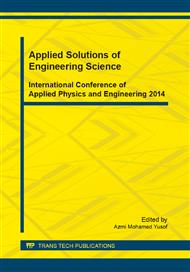[1]
Atkinson, W.: Inlet Manifold Design and Theory in Regards to Maximizing Volumetric Efficiency. Chem. Eng. J. 84(1), 1-6 (2000).
Google Scholar
[2]
Jadhav, P., Nanda, A., Tripathi, M., Kumar, A. et al.: Design Considerations for Plastic Fuel Rail and Its Benefits. SAE Technical Paper 2014-01-1041, (2014), doi: 10. 4271/2014-01-1041.
DOI: 10.4271/2014-01-1041
Google Scholar
[3]
P.J. Bates, J.C. Mah, X.P. Zou, C.Y. Wang, Bobbye Baylis. : Vibration welding air intake manifolds from reinforced nylon 66, nylon 6 and polypropylene. Composites Part A: Applied Science and Manufacturing 35(9): 1107-1116 (2004).
DOI: 10.1016/j.compositesa.2004.02.019
Google Scholar
[4]
Ceviz, M. A. and Akin, N.: Design of a New SI Engine Intake Manifold with Variable Length Plenum. Journal of Energy Conversion and Management. 51: pp.2239-2244(2010).
DOI: 10.1016/j.enconman.2010.03.018
Google Scholar
[5]
G. De Nicolao, R. Scattolini and C. Siviero.: Modelling The Volumetric Efficiency Of I. C Engines: Parametric, Non-Parametric And Neural Techniques. Control Eng. Practice, Vol. 4, No. 10, pp.1405-1415, (1996).
DOI: 10.1016/0967-0661(96)00150-5
Google Scholar
[6]
Michael Benson, Tomohiko Tanaka, John K. Eaton. : Effects of Wall Roughness on Particle Velocities in a Turbulent Channel Flow. Journal of Fluids Engineering March 2005, Vol. 127 / 250-256 (2005).
DOI: 10.1115/1.1891149
Google Scholar
[7]
James B. Taylor, Andres L. Carrano, Satish G. Kandlikar. : Characterization of the effect of surface roughness and texture on fluid flow—past, present, and future. International Journal of Thermal Sciences 45 (2006) 962–968.
DOI: 10.1016/j.ijthermalsci.2006.01.004
Google Scholar
[8]
Koura M. M. (1980).: The effect of surface texture on friction mechanisms. Wear 63(1): 1–12.
DOI: 10.1016/0043-1648(80)90069-1
Google Scholar
[9]
C. Kleinstreuer, J. Koo. : Computational Analysis of Wall Roughness Effects for Liquid Flow in Micro-Conduits. Journal of Fluids Engineering January, Vol. 126 /1-9 (2004).
DOI: 10.1115/1.1637633
Google Scholar
[10]
Ganesan V. 2004. Internal Combustion Engines (2nd edn. ). Tata McGraw-Hill Publishing Company Limited, Singapore.
Google Scholar
[11]
Mittal, M., Schock, H., Vedula, R., and Naguib, A.: Establishment of a Database by Conducting Intake Manifold and In-Cylinder Flow Measurements inside an Internal Combustion Engine Assembly. SAE Technical Paper 2013-01-0565, 2013, doi: 10. 4271/2013-01-0565.
DOI: 10.4271/2013-01-0565
Google Scholar
[12]
S. Mat and M. A. Salim, : The Performance Improvement for Plenum inside Intake Manifold in Automobile Vehicles Engine : Journal of Eletrical and Mechanical Engineering Vol 2. No 1 (2011).
Google Scholar
[13]
D, S., Gokhale, A., and N, K.: Design and Development of a Novel Charge Boosting System for a Single Cylinder SI Engine: SAE Technical Paper 2014-01-1707, (2014).
DOI: 10.4271/2014-01-1707
Google Scholar


